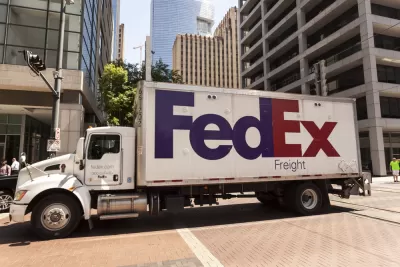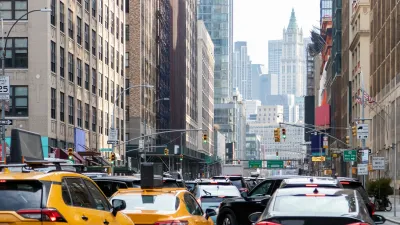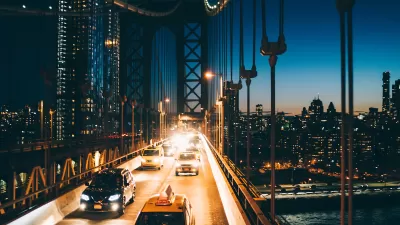With more and more products available for doorstep delivery, Janette Sadik-Khan argues that policymakers have to proactively face the imminent "delivery deadlock" and take control of curb management.

Former New York City transportation commissioner Janette Sadik-Khan, writing in Bloomberg CityLab, argues that cities must address the congestion and pollution caused by a growing number of delivery vehicles on city streets. "One online order can easily generate multiple vehicle trips via the U.S. Postal Service, UPS or private carriers to deliver even the tiniest items — a package of paper towels arrives in the morning, a box of cereal arrives midday and a 2.5-ounce tube of bike-chain lube is handed off in the afternoon. While we love to see the delivery person pull up with that must-have item," Khan writes, "we don’t love the trucks double- and triple-parked outside, blocking traffic, buses and bike lanes — not to mention the negative impact they have on the brick-and-mortar businesses struggling to stay open nearby."
A report from the National Association of City Transportation Officials, Bloomberg Associates, and the Pembina Institute "calls for urgent action by cities to ward off this gathering delivery deadlock" and suggests methods for managing freight movement, including "neighborhood-scale delivery hubs, loading zones that utilize pricing technology, citywide e-commerce charges and new systems that make the most of underused inland waterways." According to Khan, "It’s increasingly up to cities to take action and experiment" with programs like Santa Monica's "zero-emissions delivery zone," which gives "priority to zero-emission vehicles and more efficient delivery."
"Large and cumbersome delivery trucks are out of place on city streets, creating chaos and danger by blocking sightlines of people trying to cross the street." While this can be mitigated by compact delivery vehicles, Khan suggests that cities can implement policy-based solutions to manage the use of street and curb space more effectively. She points to resources like SharedStreets, a NACTO initiative "that creates detailed data maps of the vast curbside network, allowing cities to analyze, manage, price and allocate space depending on needs at specific times, days and on changing needs." Tools like this, Khan writes, "can help city leaders rein in the worst effects of today’s e-commerce boom, and protect residents and road users from whatever new disruption awaits."
FULL STORY: It’s City vs. Delivery Vans, and the Vans Are Winning

Planetizen Federal Action Tracker
A weekly monitor of how Trump’s orders and actions are impacting planners and planning in America.

Restaurant Patios Were a Pandemic Win — Why Were They so Hard to Keep?
Social distancing requirements and changes in travel patterns prompted cities to pilot new uses for street and sidewalk space. Then it got complicated.

Map: Where Senate Republicans Want to Sell Your Public Lands
For public land advocates, the Senate Republicans’ proposal to sell millions of acres of public land in the West is “the biggest fight of their careers.”

Maui's Vacation Rental Debate Turns Ugly
Verbal attacks, misinformation campaigns and fistfights plague a high-stakes debate to convert thousands of vacation rentals into long-term housing.

San Francisco Suspends Traffic Calming Amidst Record Deaths
Citing “a challenging fiscal landscape,” the city will cease the program on the heels of 42 traffic deaths, including 24 pedestrians.

California Homeless Arrests, Citations Spike After Ruling
An investigation reveals that anti-homeless actions increased up to 500% after Grants Pass v. Johnson — even in cities claiming no policy change.
Urban Design for Planners 1: Software Tools
This six-course series explores essential urban design concepts using open source software and equips planners with the tools they need to participate fully in the urban design process.
Planning for Universal Design
Learn the tools for implementing Universal Design in planning regulations.
Heyer Gruel & Associates PA
JM Goldson LLC
Custer County Colorado
City of Camden Redevelopment Agency
City of Astoria
Transportation Research & Education Center (TREC) at Portland State University
Camden Redevelopment Agency
City of Claremont
Municipality of Princeton (NJ)





























